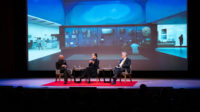On Newbury Street you’ll find more traditional art mediums, such as painting and photography, whereas cutting edge work—site-specific wall art, installations, and video projection—is concentrated in the South End. New England is a region steeped in history, so you might be surprised to discover that Boston has a strong contemporary art scene—mainly because it’s home to a large and vibrant community of artists. Take the city of Somerville. A bedroom suburb just north of town, it boasts the second highest number of artists per capita nationwide (second only to New York City).
You’ll find impressive homegrown talent on display in Boston alongside an array of well-known national and international artists. Gallery directors are more than happy to help you learn about what inspires their artists—they’ll give you the equivalent of a mini-course in art history and aesthetics—but don’t mistake this eagerness for a hard sell. Generally speaking, Boston’s art dealers are no-pressure. (If you are interested in buying, you’ll be happy to discover that their prices are generally lower than in New York.)

Photo courtesy Greater Boston CVB/ FayFoto
The Dona Flor ceramics gallery on Newbury Street, which is home to the city’s largest concentration of art galleries.
1. Back Bay
Newbury Street, in Boston’s Back Bay neighborhood, was traditionally the place to go gallery hopping—until the mid-1990s, when skyrocketing rents forced many dealers to move to the South End and upscale fashion boutiques such as Armani and Burberry took their place. But, block per block, there are still more art galleries on Newbury Street than in any other part of the city.
One thing you’ll notice about Back Bay is that the streets follow a grid pattern. Newbury runs parallel to Commonwealth Avenue, which is more residential in character, and parallel to Boylston, which is more commercial; all three are broken into blocks by alphabetically ordered cross streets. This rectilinear regularity is a rarity in Boston, where roads usually twist and turn to follow the property lines of long-dead colonists. The reason is that unlike downtown, Back Bay was built all at once in the late 1800s on land reclaimed from the bay.
Although it’s easy to navigate the streets of Back Bay, you’ll have an impossible time finding on-street parking—so don’t even try. Besides, you won’t need a car. Newbury Street is so pleasant to walk that you’d be foolish to visit it any other way. To boot, many of the street’s galleries conveniently share space in the same buildings. After you hit one building, you can pause for a drink next door, or browse at a clothing shop, then move to the next cluster of galleries.
At No. 38 Newbury Street, for instance, you can ride an elevator up to the fourth floor and find four different galleries, each with a very distinct focus. The Robert Klein Gallery, is a true Newbury Street institution—and the largest gallery in New England focusing exclusively on photography. Klein carries an impressive array of work by established contemporary photographers—museum greats like Annie Leibowitz, Sally Mann, and Herb Ritts, to name just a few—work by past masters including Ansel Adams, Diane Arbus, and Charles Sheeler, and new items by up-and-coming talent including Elena Dorfman and Jerry Uelsmann.
Also on the fourth floor of 38 Newbury Street, check out Acme Fine Art. Gallery director Dave Cowan has an eye for 20th century American painting in the abstract, surrealist, and cubism vein, but he’ll also offer the occasional painting by social realists such as Reginald Marsh—who has a tendency towards the geometric and the colorful—as well as small sculptures. Alpha Gallery, also at 38 Newbury, has a similar focus—but its mission, since opening in 1967, has also been to showcase talent from the Boston area.
Housed in its own building, one of the most important art venues on all of Newbury Street is the Barbara Krakow Gallery, where you’ll find works by the biggest names in the contemporary art world over the past half century. Located in a beautifully sky-lit space on the top floor of No. 10, it shows everything from Josef Albers, Jenny Holzer, and Donald Judd, to Edward Ruscha, Sol Lewitt, and Kiki Smith—a truly world-class line up.



